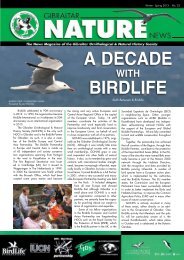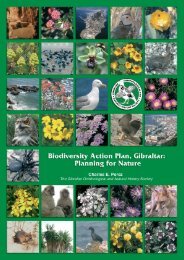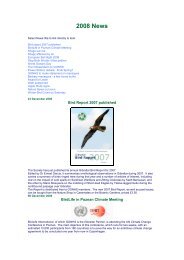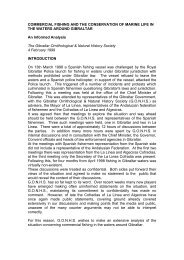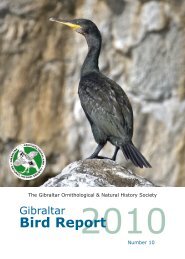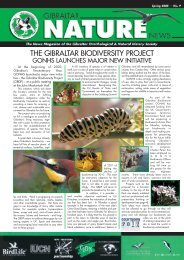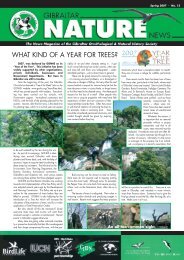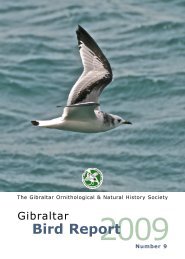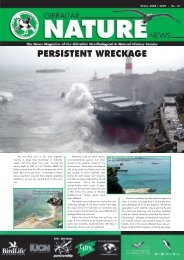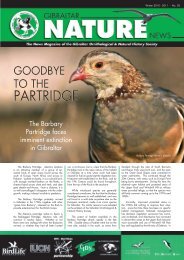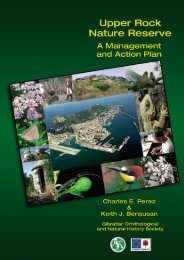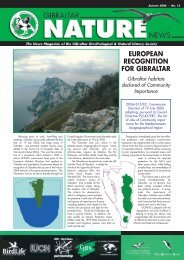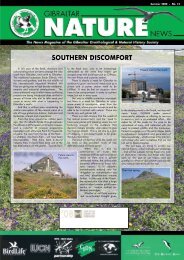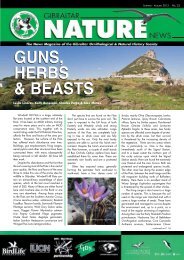ure News 11 - Gibraltar Ornithological & Natural History Society
ure News 11 - Gibraltar Ornithological & Natural History Society
ure News 11 - Gibraltar Ornithological & Natural History Society
Create successful ePaper yourself
Turn your PDF publications into a flip-book with our unique Google optimized e-Paper software.
GIBMANATUR:<br />
<strong>Gibraltar</strong>-Morocco Interreg Project news<br />
The <strong>Gibraltar</strong>-Morocco Interreg IIIA<br />
Project GIBMANATUR (I and II), a collaboration<br />
between GONHS and the Institut<br />
Scientifique of the Université Mohammed V<br />
Rabat-Agdal, has sadly come to an end. The<br />
project, which started in 2003 with a major<br />
conference on the Barbary macaque, has<br />
been a great success. One of its main aims<br />
was to establish close links between <strong>Gibraltar</strong><br />
and Morocco and it has done so overwhelmingly<br />
well.<br />
Among the main activities of the project<br />
was a bird ringing programme during the<br />
spring and autumn months of 2004 to 2008.<br />
The operations were extremely successful and<br />
5344 birds were processed in total. The<br />
species present and their patterns of occurrence<br />
have revealed interesting facts about<br />
the marshes of Restinga-Smir, as a site. Smir<br />
is an important wintering site for Penduline<br />
Tits: it has emerged that they are regular here<br />
and nowhere else in Morocco, and the population<br />
is larger than anyone had thought.<br />
Extensive surveys of birds in different habitats<br />
in the area have also been carried out, as well<br />
as surveys in other areas, especially wetlands,<br />
of northern Morocco.<br />
Another important part of Interreg was<br />
the extensive winter surveys of wetland birds<br />
in northern Morocco, a contribution to the<br />
national wetland bird count co-ordinated<br />
every year by the Institut. Areas covered by<br />
the GONHS team include Smir on the<br />
Mediterranean coast to Asilah and Larache<br />
on the Atlantic side.<br />
Interesting results have been obtained<br />
both from the ringing data and the bird surveys.<br />
Some of the species recorded are rare<br />
in Morocco and any records of these contribute<br />
to knowledge of their status and distribution.<br />
These include: Great Bittern, Little<br />
Bittern, Great Egret, Marbled Duck,<br />
Ferruginous Duck, Great Bustard, Spotted<br />
and Little Crake, Jack Snipe, Lesser Crested<br />
Tern, Moustached Warbler, Penduline Tit,<br />
Alpine Chough and Tree Sparrow. Other<br />
species recorded are true vagrants: Ringnecked<br />
Duck, Rüppell’s Vult<strong>ure</strong>, Icterine<br />
Warbler, Lesser Whitethroat and Hooded<br />
Crow.<br />
As part of the bird ringing programme,<br />
GONHS volunteer and ringing trainer Ian<br />
Thompson has trained two Moroccan students<br />
from the University of Tetouan:<br />
Mohamed Amezian and Abdelahak Elbanak.<br />
Mohamed was further assisted with a scholarship<br />
from GONHS, which he fully deserved<br />
given his impressive academic ability and<br />
eagerness to learn. He has now obtained his<br />
BTO C-grade ringing license and a Moroccan<br />
ringing license. We hope that the students,<br />
and Mohamed in particular, will continue to<br />
ring in Morocco for years to come.<br />
As a result of Interreg, a series of publications<br />
have already been produced by the<br />
<strong>Gibraltar</strong> and Moroccan partners, dealing<br />
mainly with birds and invertebrates in northern<br />
Morocco. More publications will follow<br />
soon, including some on plants.<br />
A report on the project is currently being<br />
prepared, to be submitted to the EU and the<br />
<strong>Gibraltar</strong> Government, who co-sponsored the<br />
project.<br />
The project came to a close with a two<br />
week expedition to the south of Morocco in<br />
November, in order to survey habitats, and<br />
record and collect succulent plants, invertebrates,<br />
birds, reptiles, amphibians and scorpions.<br />
The range of habitats sampled was<br />
enormous, from the Alpine High Atlas to the<br />
desert near Algeria and the arid Atlantic coast<br />
of southwest Morocco. The work will further<br />
help discover and understand Morocco’s biodiversity.<br />
Even though the project is now over, we<br />
will continue to work closely with our<br />
Moroccan colleagues at the Universities of<br />
Rabat and Tetouan, which we view as permanent<br />
partners. Given<br />
the strong links<br />
forged between us,<br />
there is a strong<br />
desire to work<br />
together in the fut<strong>ure</strong>.<br />
Although funding for<br />
<strong>Gibraltar</strong>-Morocco<br />
has not been<br />
approved for the next<br />
tranche of EU funding,<br />
GONHS will<br />
continue to explore<br />
avenues to ens<strong>ure</strong><br />
that our collaboration<br />
continues.<br />
Expedition to southern Morocco (2008)<br />
Abdelahak Elbanak &<br />
Mohamed Amezian training<br />
at Jews’ Gate, <strong>Gibraltar</strong><br />
NOTES & NEWS<br />
BRANCHED CARLINE THISTLE<br />
The flat-topped carline thistle Carlina hispanica<br />
is very common and widespread on the Rock.<br />
On the other hand, the Branched carline thistle<br />
Carlina racemosa is very rarely seen. This year,<br />
after twenty years since the last one was seen on<br />
the Rock at Bruce’s Farm firebreak, a solitary<br />
plant appeared in the Alameda Botanic<br />
Gardens. The plant was quite small, and failed<br />
to provide viable seeds.<br />
CHRISTIANNE’S DIARY<br />
“My Nat<strong>ure</strong> Diary” by Christianne Fagan published<br />
as a limited edition just before Christmas<br />
is a delightful look at nat<strong>ure</strong> in <strong>Gibraltar</strong><br />
through a schoolgirl’s eyes. Written in the early<br />
1980s, it records, in text, sketches and water<br />
colours, many different aspects of nat<strong>ure</strong>, many<br />
in the Botanic Gardens which the author frequented<br />
as a child. The notes are fascinating –<br />
and while not meant to be a textbook, give a<br />
real feel for what nat<strong>ure</strong> in <strong>Gibraltar</strong> has to<br />
offer. Many of the descriptions are exquisite,<br />
and to anyone who has lived in the same space<br />
as Christianne, generate an intense feeling of<br />
nostalgic warmth. A charming book that every<br />
nat<strong>ure</strong> lover with a connection with <strong>Gibraltar</strong><br />
should have – and will treas<strong>ure</strong>.<br />
CLEARING OF CHASMANTHE<br />
ON ST MICHAEL’S CAVE FIRE-<br />
BREAK<br />
For the past couple of years, the Upper Rock<br />
Team currently working under GONHS have<br />
been removing introduced species of plants<br />
from various places around the Nat<strong>ure</strong> Reserve.<br />
Recently they have turned their attention to<br />
removing the African Corn Flag Chasmanthe<br />
floribunda. This South African species is a garden<br />
escape, and has established itself in several<br />
places within the Nat<strong>ure</strong> Reserve, especially<br />
on the firebreak near St Michael’s Cave. It is an<br />
aggressive species, out-competing native<br />
species at an alarming rate on clearings and<br />
along roadsides. The Team has a hard task<br />
ahead of them!<br />
GIBRALTAR NATURE NEWS<br />
3



